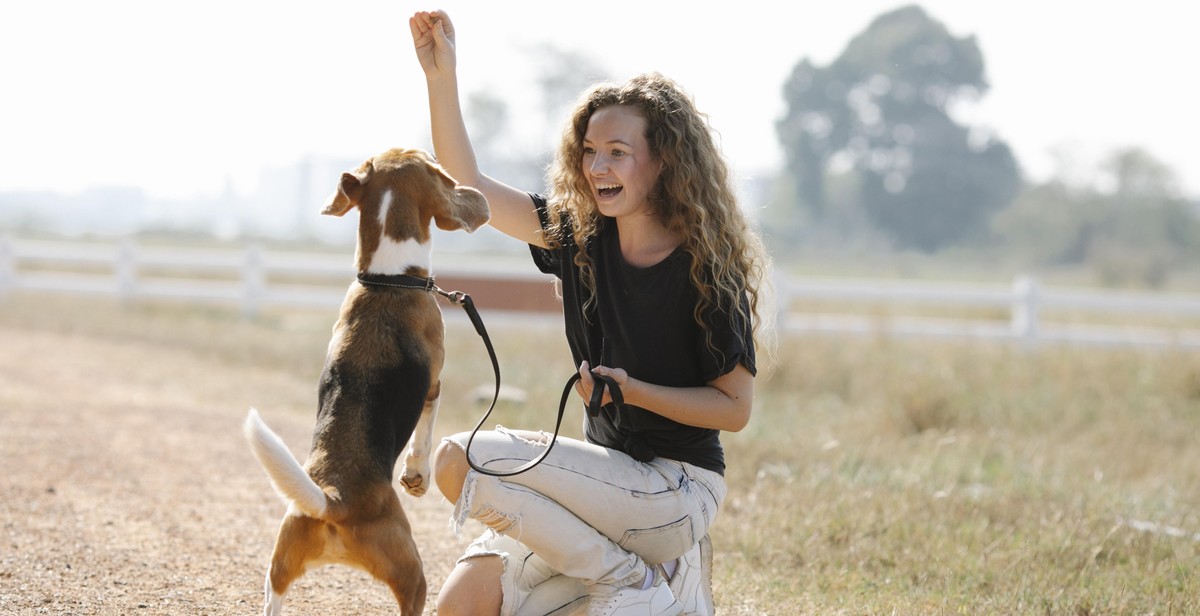How to Teach Your Dog Basic Commands: Sit, Stay, and Recall Training Techniques
Teaching your dog basic commands such as sit, stay, and recall is essential for their safety and your peace of mind. These commands can help you control your dog’s behavior and prevent them from getting into dangerous situations. However, training your dog can be a challenging task, especially if you are a first-time dog owner.
In this article, I will share with you some of the best training techniques to teach your dog basic commands. As a professional dog trainer with over ten years of experience, I have worked with various breeds and temperaments, and I can assure you that these techniques are effective and easy to follow.
Why Teach Your Dog Basic Commands?
Teaching your dog basic commands is not just about obedience; it’s also about building a strong bond with them. When you train your dog, you establish trust and respect, which can improve their overall behavior and make them happier. Basic commands can also help you communicate with your dog effectively, reducing frustration and misunderstandings.
The Three Basic Commands: Sit, Stay, and Recall
The three basic commands that every dog should know are sit, stay, and recall. These commands are simple yet crucial for your dog’s safety and your peace of mind. In the following sections, I will explain how to train your dog to master each of these commands.
Why Teach Your Dog Basic Commands?
Teaching your dog basic commands is essential for their safety, well-being, and overall behavior. Basic command training helps establish a stronger bond between you and your furry friend, and it also helps you communicate with them effectively.
Benefits of Basic Command Training
Basic command training offers numerous benefits to both you and your dog. For instance, it helps to:
- Improve your dog’s behavior
- Enhance your dog’s socialization skills
- Boost your dog’s confidence and self-esteem
- Increase your control over your dog’s actions
- Reduce the risk of accidents or injuries
Moreover, basic command training helps to keep your dog mentally stimulated and physically active. It also makes your dog more obedient, which can make your life much easier and less stressful.
Establishing a Stronger Bond with Your Dog
Training your dog basic commands is one of the best ways to establish a stronger bond with them. When you train your dog, you spend quality time with them, and this helps to build trust and respect between you and your furry friend. Additionally, training helps you understand your dog’s behavior better, and this makes it easier for you to respond to their needs and desires.
Overall, teaching your dog basic commands is an essential part of being a responsible pet owner. It not only helps to keep your dog safe and well-behaved, but it also strengthens the bond between you and your furry friend.

Preparation for Training
Choosing the Right Time and Place
Choosing the right time and place for your dog’s training is crucial for their success. It’s important to select a location that is quiet and free from distractions, such as other people or animals. This will help your dog to focus on the training and not be tempted to run off or play with other dogs.
It’s also important to choose a time when your dog is most alert and receptive. Avoid training your dog when they are tired, hungry, or overly excited. A good time for training is usually after a meal and when your dog has had some exercise.
Gathering Supplies
Gathering the right supplies before beginning your dog’s training will make the process much smoother. You will need a few basic supplies such as:
- A leash and collar
- Treats or rewards
- A clicker (optional)
- A training mat or towel (optional)
Make sure to choose high-quality treats that your dog loves and will be motivated to work for. You can also use your dog’s regular food as a reward, but make sure to adjust their meals accordingly to avoid overfeeding.
Having these supplies on hand will help you to stay organized and focused during training sessions, and will also make the experience more enjoyable for both you and your dog.
Teaching the ‘Sit’ Command
The ‘sit’ command is one of the most basic and essential commands that every dog should learn. It is a great way to establish control and discipline over your dog, and it can also be useful in many situations, such as when you need your dog to stay still or when you need to put on a leash.
Step-by-Step Guide to Teaching ‘Sit’
- Start by holding a treat in front of your dog’s nose.
- Move the treat slowly up and over your dog’s head. As your dog follows the treat with their nose, their bottom will naturally lower to the ground.
- As soon as your dog’s bottom touches the ground, say “sit” and give them the treat.
- Repeat this process several times until your dog starts to associate the word “sit” with the action of sitting down.
- Once your dog has mastered the command with the treat, start gradually reducing the frequency of treats until your dog can sit on command without a treat.
Troubleshooting Common Issues
If your dog is having trouble learning the ‘sit’ command, try the following:
- Make sure you are using a high-value treat that your dog really wants.
- Try using a hand signal, such as holding your hand up with your palm facing out, to reinforce the verbal command.
- Be patient and consistent, and practice the command in short sessions several times a day.
Remember, every dog learns at their own pace, so don’t get discouraged if your dog doesn’t pick up the command right away. With practice and patience, your dog will learn to sit on command in no time!

Teaching the ‘Stay’ Command
The ‘stay’ command is crucial for teaching your dog to remain in a specific position until you release them. It helps to keep your dog safe and under control in various situations such as crossing roads, when visitors arrive at your home, or when you need to leave your dog for a few minutes.
Step-by-Step Guide to Teaching ‘Stay’
- Begin by commanding your dog to ‘sit’ or ‘down.’
- Hold your hand up with the palm facing your dog and say ‘stay.’
- Take a step back and observe your dog. If they remain in the same position, reward them with a treat and praise them with ‘good stay.’
- Gradually increase the distance and duration of the ‘stay’ command. You can also add distractions like toys or treats to test your dog’s focus.
- Release your dog with a command like ‘okay’ or ‘free.’
Troubleshooting Common Issues
It’s common for dogs to break the ‘stay’ command, especially when they’re learning. Here are some tips to help you overcome common issues:
- If your dog breaks the ‘stay’ command, calmly guide them back into position and repeat the command.
- Practice in a quiet environment without distractions before adding distractions.
- Don’t punish your dog for breaking the ‘stay’ command. Instead, reward them when they get it right.
| Punishment | Effect on Dog |
|---|---|
| Physical punishment | Increases fear and aggression |
| Verbal punishment | Creates confusion and anxiety |
Teaching the ‘Recall’ Command
The recall command, also known as ‘come’, is one of the most important commands for a dog to learn. It can help keep your dog safe in situations where they may be in danger, such as running towards a busy road or approaching an aggressive dog.
Step-by-Step Guide to Teaching ‘Recall’
- Choose a quiet area free from distractions to begin training.
- Put your dog on a leash and let them wander a few feet away from you.
- Call your dog’s name followed by the recall command, such as “Buddy, come”.
- When your dog comes to you, reward them with a treat and praise.
- Repeat this process, gradually increasing the distance between you and your dog.
- Once your dog is responding well to the recall command on the leash, try it off-leash in a secure area.
- Continue practicing the recall command in various environments and situations.
Troubleshooting Common Issues
If your dog is struggling with the recall command, there may be a few common issues to address:
- Distractions: If your dog is easily distracted, try training in a quieter area and gradually increase the level of distractions.
- Timing: Ensure that you are calling your dog at the right time, not after they have already wandered away or become too engrossed in an activity.
- Negative associations: If your dog associates coming to you with something negative, such as going home or ending playtime, they may be less likely to respond to the recall command. Try associating the command with positive rewards, such as treats and playtime.
| Tip | Description |
|---|---|
| Consistency | Use the same command and reward system every time you train. |
| Positive reinforcement | Reward your dog every time they respond to the recall command, even if they come slowly. |
| Patience | Training takes time and practice. Be patient and persistent. |
Tips for Successful Training
Training your dog can be a fun and rewarding experience for both you and your furry friend. Here are some tips to make your training sessions successful:
Keep Training Sessions Short and Fun
Dogs have a short attention span, so it’s important to keep training sessions short and focused. Aim for 10-15 minutes per session, and make sure to keep things fun and engaging for your dog. Incorporate playtime and treats to keep your dog motivated and excited to learn.
Use Positive Reinforcement
Positive reinforcement is key to successful training. Reward your dog for good behavior with treats, praise, and affection. Avoid using punishment or negative reinforcement, as this can cause your dog to become anxious or fearful.
Be Patient and Consistent
Training takes time and patience, so don’t expect your dog to learn everything overnight. Be consistent with your training methods and use the same commands and rewards every time. With time and patience, your dog will learn and become a well-behaved companion.
- Keep training sessions short and fun
- Use positive reinforcement
- Be patient and consistent
By following these tips, you can make your training sessions enjoyable and effective for both you and your dog. Remember to have fun and enjoy the process!
Conclusion
Training your dog to follow basic commands is an essential part of responsible pet ownership. It not only helps keep them safe but also strengthens the bond between you and your furry friend. By using positive reinforcement techniques and consistency, you can teach your dog to sit, stay, and come when called.
Remember to keep training sessions short and fun, and always end on a positive note. If your dog seems to be struggling with a certain command, don’t get frustrated. Take a step back, break the task into smaller parts, and work on building up to the full command. And don’t forget to reward your dog for their hard work and progress.
It’s also important to keep in mind that training is an ongoing process. Even once your dog has mastered these basic commands, it’s important to continue reinforcing them regularly to keep them sharp and responsive.
Final Thoughts
Teaching your dog basic commands is a rewarding experience for both you and your furry companion. With patience, consistency, and positive reinforcement, your dog can learn to sit, stay, and come when called. Not only will this make your life easier, but it will also help keep your dog safe and happy.
So, what are you waiting for? Grab some treats, clear your schedule, and start training your pup today!
